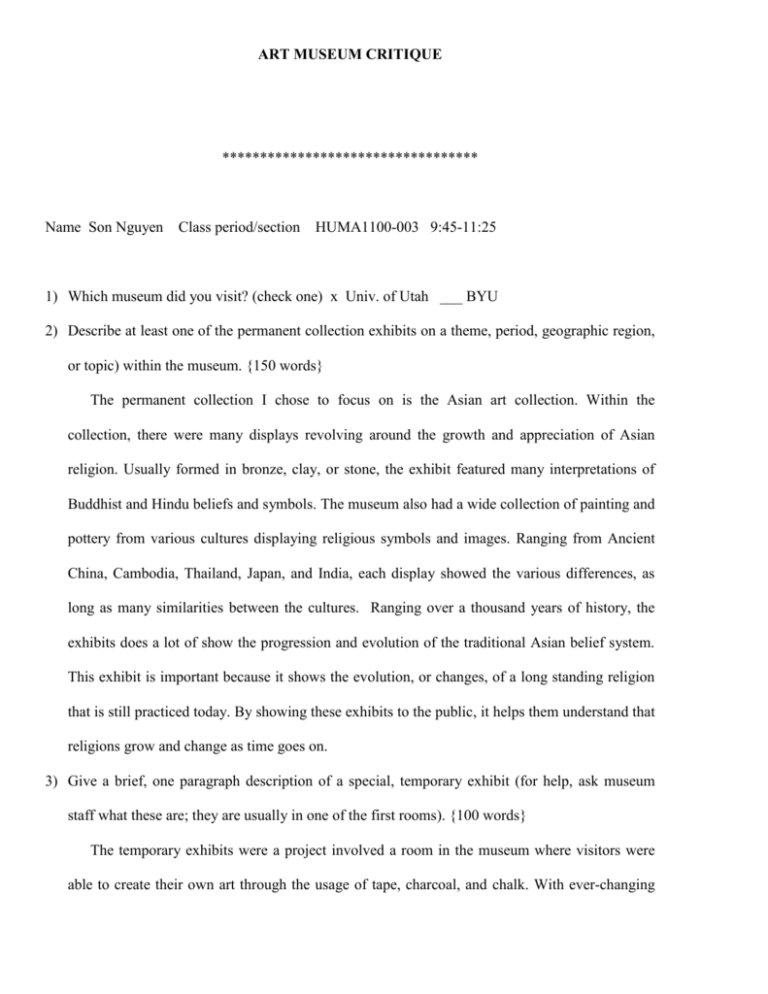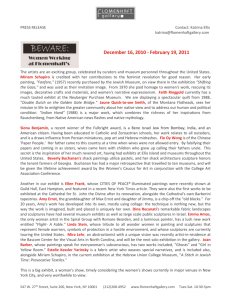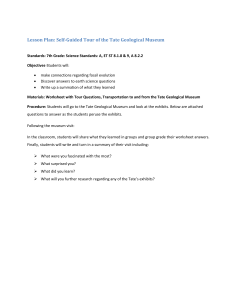OCR Document - WordPress.com
advertisement

ART MUSEUM CRITIQUE
**********************************
Name Son Nguyen
Class period/section
HUMA1100-003 9:45-11:25
1) Which museum did you visit? (check one) x Univ. of Utah ___ BYU
2) Describe at least one of the permanent collection exhibits on a theme, period, geographic region,
or topic) within the museum. {150 words}
The permanent collection I chose to focus on is the Asian art collection. Within the
collection, there were many displays revolving around the growth and appreciation of Asian
religion. Usually formed in bronze, clay, or stone, the exhibit featured many interpretations of
Buddhist and Hindu beliefs and symbols. The museum also had a wide collection of painting and
pottery from various cultures displaying religious symbols and images. Ranging from Ancient
China, Cambodia, Thailand, Japan, and India, each display showed the various differences, as
long as many similarities between the cultures. Ranging over a thousand years of history, the
exhibits does a lot of show the progression and evolution of the traditional Asian belief system.
This exhibit is important because it shows the evolution, or changes, of a long standing religion
that is still practiced today. By showing these exhibits to the public, it helps them understand that
religions grow and change as time goes on.
3) Give a brief, one paragraph description of a special, temporary exhibit (for help, ask museum
staff what these are; they are usually in one of the first rooms). {100 words}
The temporary exhibits were a project involved a room in the museum where visitors were
able to create their own art through the usage of tape, charcoal, and chalk. With ever-changing
canvases of tables and walls, visitors were encouraged to add on and collaborate to the overall
artwork.
The second temporary exhibit showed a large canvas painted in charcoal, displaying an
artwork created between eight different University of Utah students simultaneously, creating
artwork whilst also adapting to the artwork of the other artists. While this system meant that each
artist could be unique, they also had to adapt their styles to match the surroundings.
4) What do you think the museum administration and/or exhibit curators want you to learn or gain
from the exhibits you viewed? {100 word minimum}
The objectives of the museum administration and/or exhibit curators want their visitors to
gain and learn from the exhibits are to broaden their horizons. By showing the cultures and history of
other civilizations, it can help people understand a world beyond the world they already live in.
Through the explanation and visual exhibits of different religion and cultural differences, the
museum is attempting to give explanation; a fuller understanding of humanities and of the world.
This allows museum visitors to learn culture and history without travelling to other countries around
the world, an opportunity that many visitors cannot afford to do.
5) What kind of information is provided about the works? Where might you look for further
information if you were interested? (Name three possibilities)
1. The information plaque by the exhibit.
2. Library
3. Online
4. Curator
6) Choose several works that particularly appealed to you. Explain why you were drawn to these
works. Comment on the subject, style, medium, time period, etc. Who were the artists? What
message do you think the artists were trying to convey in the works you chose to discuss? This
question must be answered in its entirety. {This should be at least 500 words}
The first work I chose to write about was the works of Gilbert Stuart. Active during early
American history, Stuart works on various portraits where he was able to perfect the fluid technique
popular at the time. At the exhibit, two painting were shown: Mr. Simon Walker and Mrs. Simon
Walker. These two paintings, painted in 1802, were approximately 30 inches by 20 inches and
painted in oil. The message I think that the exhibit shows was to show the popularized style at the
time. What I really thought was interesting was that Gilbert Stuart gone on to paint various portraits
of George Washington, one of which was engraved into the U.S. dollar bill.
Secondly, the next artwork I chose to write about is called “The Ambush of Captain Allen
McLane” by James Peale. I think the subject of this painting is very interesting because it showed a
snapshot of the American Revolutionary War. Though the subject is brutal, the styling of the
painting is elegant and beautiful. Painted in oil, the artist chose very colorful colors to contrast the
subject. This painting stood out because it was very effective at conveying the traits that Charles
Peale possessed such as strength and nobility that served to commemorate the struggle of
independence in heroic overtones.
The third work I found appealing was “The Christian Martyrs’ Last Prayer” by Jean Leon
Gerome. Portrayed in the artwork is a large collection of Christians in a roman coliseum praying
seconds before encountering a lion. Painted in oil, the painting is especially interesting because of
the changes the artist made throughout its production. Initially, the Christian martyrs’ were in the
front of the painting, but as time progressed, Gerome decided to move them further back into the
painting. The historic scene stood out as important because it showed the brutalities of the Romans
to those who disagreed with their belief system.
“The Season Sarcophagus of the Constantine Period” is the next piece that stood out to me. The
piece is an actual functional casket used in Greco-roman times, approximately 325-330 AD. Carved
into the marble coffin is a depiction of the caskets owner. From the carvings in the sarcophagus,
many inferences can be made about the person inside it. The carvings also show religious and
cultural symbols that were relevant at the time. Overall, I think the main thing that stood out is the
age of the piece and the fact that it has withstood the test of time.
Another piece I found very interesting was “Shiva Nataraja.” Created in cast bronze, the piece
was created in the eleventh century and stands 27 inches high. In the statue, it shows Shiva, lord of
the dance. The dance is used to represent the constant motion of the universe. Circling around the
Shiva Nataraja is a circle of fire, a symbol of the cosmic universe. I was attracted to this piece
because it was a good expression of Indian culture and looked very difficult to construct.
7) How did the artworks you looked at relate to material we have discussed in class? (They do
relate in many ways, you just need to look for those relationships). {Minimum of 150 words}
Much of the artwork I looked at was very influenced by the Hindu and Buddhist beliefs,
many of which we discussed in class. Whilst studying the artworks, I was able to visualize the
concepts and religious characters and figures discussed in class. This included statues of Buddha
and Shiva. I saw many examples and artworks portraying very stories that we discussed in class
including The Buddha Path to Enlightenment, The Bhagavad Gita, among many others.
By being able to view the artwork of that time period, I can further understand how religion
fell into place in peoples’ lives. The religion wasn’t just something they believed in, their
religion was present in everything the people did. This is shown in the pottery and paintings
shown at the museum. Furthermore, the Japanese paintings showed a good snapshot of how the
Japanese people lived in the 17th and 18th century.
8) What was your personal reaction to this experience? Would you enjoy attending this type of
event again? Why or why not? {Minimum 100 words}
At first, I went to the museum solely to get the assignment done. However, when I began to
see the exhibits and paintings, my interests grew. Soon I began to focus less on the assignment
and more on seeing and recording all each exhibit individually. Before I knew it, four hours had
passed. Many of the artworks were very impressive and I had a very hard time realizing that the
paintings were indeed paintings, not just pictures printed. I would definitely consider returning to
the museum with friends and family to show them the cultures of the outside world.
Reflective Writing
I had to overcome various challenges to complete this assignment. Before this assignment, I
had never been to a museum. Therefore, I had no idea what to expect from the experience. Initially,
I thought it would be difficult to grasp the concepts from the museum. I did not so much as address
this issue, but rather the issue resolved itself. The museum was not as complicated as anticipated and
through the help of museum curators, I was able to complete the assignment. The information
plaques and curator were very helpful in explaining the exhibits and providing me with context of
the time period and style of artwork.
This assignment demonstrated by ability to do whatever it takes to complete my assignment
and learn. Though it was difficult due to lack of experience in history and English as a second
language, I was able to still achieve the goals set out by this assignment through hard work and my
family helping me in times of need. Though the assignment was not easy, it was my dedication to
succeed in college that drove me to complete this assignment as fully as possible.







